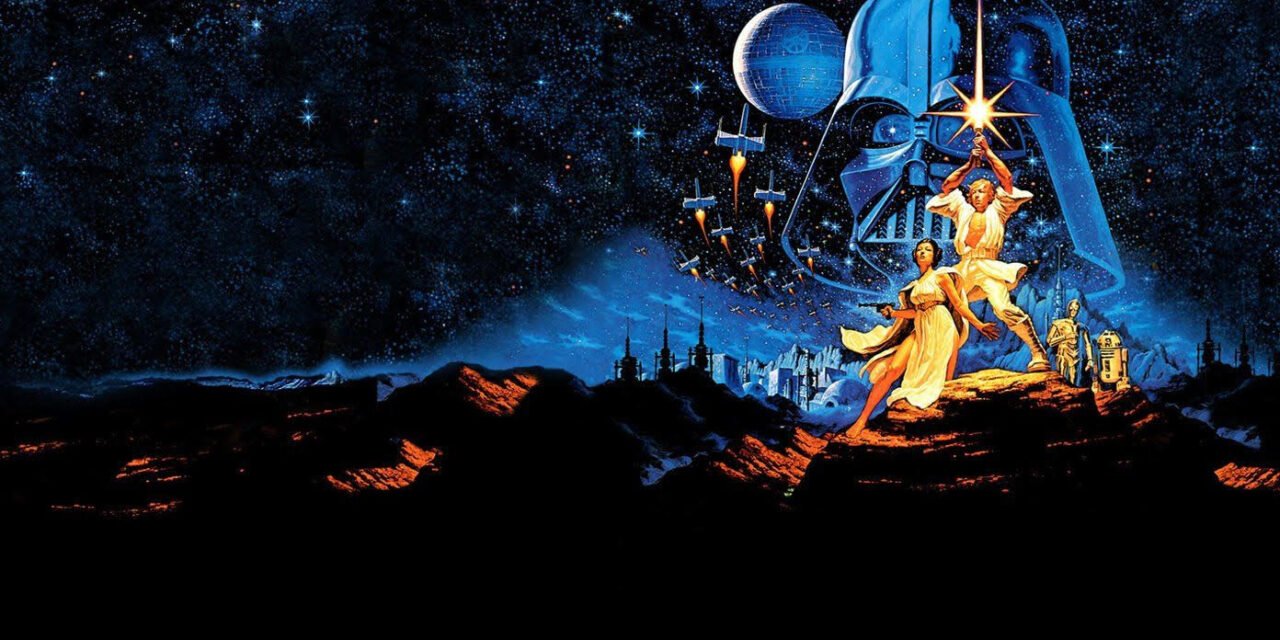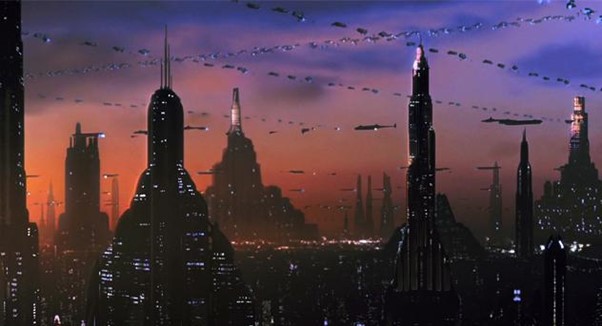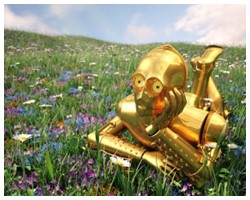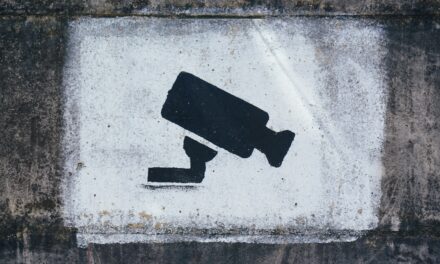Have you ever considered the political and socio-economic references of this saga? This hasn’t only captivated most of us for decades but reflected the moment in which every trilogy was made. In the following sections, I will analyze some approaches and different views.
-
The psychology of color in cinema
The use of this discipline for conveying ideas and emotions is a common resource on Star Wars. Among all the elements, colors are especially handled with mastery in the prequel trilogy.
Firstly, primary colors (blue, red and yellow) dominate the scenes, showing diversity (aliens and human beings), tolerance, and political freedom. As we move through the trilogy, the frames gradually desaturate until being dominated by blacks, greys, and reds. This change represents homogeneity: the fascism, the terror, and the violence of the Galactic Empire.
Thus, a color framework is established for relating the idea of “good” with a primary colors palette and the idea of “evil” with a gray, black, and red palette. But if we look more deeply, these palettes are related to specific socioeconomic and political organizations.
-
How does historical context reflect on the different trilogies?
As I said, the different trilogies do reflect quite sharply the moment they were made.
The original trilogy was released while the old global economic order was evolving into the current. In 1977, the Fordist way of production was starting to become worn out. The phenomenon of stagflation caught by surprise economists, because inflation and unemployment weren’t supposed to happen simultaneously, according to the theoretical model.
The energy crisis and the inability to respond were the other factors that led to perceiving global capitalism as a better order. This system is based on exchanging services and information (instead of goods), decentralising production and financing services globally, creating a culture of consumption, and spreading ICTs (Information and Communication Technologies). Although this information is now well-known, at the time little did people know about how this system would develop and its effects.
I know what you might think: How does all that complexity appear in an entertaining film for all audiences? Well, as I said, in the late 70s, little information was available on global capitalism. That’s why Lucas shows both fascination and fear with the idea of a super-advanced and globalized galaxy. The technology of the Death Star and the special effects made the spectators hold their breath in their cinema seats, even though it’s more normal for current generations. However, nothing is said about what is the productivity model which sustains that monstrous construction. What is present throughout the trilogy are nostalgic reminiscences of old ways of production, which we reckon are very far in time, making capitalism look like the most feasible option for the 70s.
In the prequel, something similar happened. At the beginning of the century, global capitalism is well-known, but its inherent contradictions are blurrier. Francis Fukuyama defended that global capitalism is the most natural form of organization, as it would help us in reaching a freer and more equitable society. Nevertheless, we can all agree that in 20 years, that hasn’t happened yet for humankind. Hence the question is: if a system is supposed to benefit humanity, why does it apparently reduce the quality of life?
On the other hand, corporativism is also the order of the day (many international organizations were starting to operate), and the Cold War had been over for a decade, so the general perception is that democracy faces other dangers. In fact, this trilogy began with a conflict involving the trade organization and the Senate and ended up uncovering what inner mechanisms were threatening democracy. I will further discuss this process in the last section.
Last but not least, in the third trilogy of Star Wars, a clash between directors is well reflected. While episodes VII and IX bring back the same argumentative thread as the original in a quite nostalgic way, episode VIII is completely disruptive and more adequate to current times. The Baby Boom generation connects better with old characters and the need to destroy an even larger weapon or numerous ships (because the argument is limited in that sense), so bringing back Lando Calrissian and even Emperor Palpatine (out of nowhere) is a success with that public in mind.
Nevertheless, the new public who has seen the 70s films are wondering “again?”. Because those episodes don’t really connect with our times, they remain shallow. The most powerful element is the character of Rey, a woman as independent and determined as Leia and one of the most important Jedi.
That’s why the Episode VIII tries to include brand new elements, such as a real struggle between good and evil in Kylo Ren (not like Anakin, who seemed to be facing an unchangeable destiny), the arms trade, and the sellers, child slavery, animal abuse, the human costs of war, the sacrifice… All those elements bring realism to the story, distinguishing it from other sci-fi adventure films.
In that episode, we get to know the characters in depth. We don’t need Rey to have an epic background to be as impressive as she is just for herself. Our generation is critical, willing to fight injustice, to be informed, to reach the truth and change things… that is achieved through Episode VIII, so we can question what is behind our wars, what is fair and what is not if the good is that good and the evil that evil.
-
The leading role of commerce and city distribution
One of the elements that normalize global capitalism throughout the trilogies is commerce as the glue in most relations.
At first, global trade is more subtle, but phenomena such as “geographical compression” are starting to emerge. What does this term mean? In the bar of Tatooine, an irrelevant corner of the galaxy, one could find any kind of alien or droid, regardless of where they come from, for trading legally or illegally. Hence, the whole galaxy can be compressed in that small bar.
Illegal trade is actually a key element during the entire saga. In fact, Han Solo assumes that his ship is involved in some fraudulent business, and he doesn’t ask any questions. The presence of Jabba the Hutt, the leader of a criminal organization that, apparently deals with sexual slavery, drugs and hired assassins, makes it even more obvious. To the point that Han Solo ends up being traded himself between the Empire and Jabba.
In that line, Episode VIII answers the question of the first section “if a system is supposed to benefit humanity, why does it apparently reduce the quality of life?” It does, but not for everybody. The winners of capitalism enjoy their fortunes in what seems a spacey Las Vegas, the city of Canto Bight. They enjoy playing in the casino and betting in alien horse races; animals cared for by enslaved children. And what do they do for a living? Easy, in a scene, character says “which business do you think that gives such an amount of money? Trade of arms”.
But coming back to the original trilogy, that illegal trade seems to be relegated to ethnic ghettos in the periphery of the galaxy, where aliens and droids live. On the other hand, the Empire is mostly dominated by white men and situated in the center of the galaxy. Some authors believe this is a metaphor for European colonizers during the imperialism of the XIX century. Yet, there’s a more recent trend that can be observed in any big city: gentrification. The renovation and investment in a deteriorated area most times implies kicking out poor residents to peripheral areas in order to fill those spaces with wealthier inhabitants. This is what happened in the district of Soho, London.
The trade topic is transversal in the prequel too. Coruscant is an attractive representation of the center of commerce, hosting the other democratic institutions too. This city seems to be built only for that purpose, and it reminds the viewer of any American city on the East Coast. It can even evoke the cold machine-dominated atmosphere of Blade Runner, in which the individual is absorbed by the urban atmosphere.
-
Universal politics
The way commerce and politics are intertwined in the prequel is evident. As I said before, there’s a conflict involving the Federation of Commerce and the Senate, as the planet of senator Padme Amidala suffers a trade embargo. The use of fear, uncertainty, and mistrust leads to the destruction of democracy and it all starts with trade issues. But how did the process gradually develop?
The institutions were corrupted from the start, Sith’s presence was starting to dominate, and nobody gave credit to that fact until it was too late. The creation of new political enemies was the next step and, after achieving some support from various galactic systems, an anti-democratic movement emerged.
The question always present in politics (freedom or security?) became more present than ever in that moment. So the balance was tipped in favor of security (or what the Senate believed was security), laying the foundations of the fascist Galactic Empire. Sounds familiar?
Padme made the mistake of trusting the democratic system blindly, instead of questioning its flaws to do something about it. In the 2000s, corporativism, conservatism and faith in institutions to empower individuals were dominating the political sphere. This trend clearly reflects on her behavior.
And she didn’t fail alone, the Jedi council wasn’t much better. Anakin, already wary of democracy, found his thirst for power fed when the Jedis were suspicious of him and Senate members. But the moment Jedis sealed their destiny was when Obi-wan, who was strict with the Jedi code, started to apply it inconsistently. The worst thing is that they ended up as victims of the first genocide of the Galactic Empire.
-
Conclusion
As you can see, Star Wars reflects the reality of the different economic and political systems, real-life events, and current issues of democratic societies.
There are other interesting topics, such as feminism, ethnic representation, and generational trauma, which I had to leave aside for a matter of length.
My reflection is partly inspired by some essays in the book “Star Wars. Filosofía rebelde para una saga de culto” by Carl Silvio and Tony M. Vinci. If you’re interested in the topics I left behind, this book is a great place to start.











